Southwold
| Southwold | |
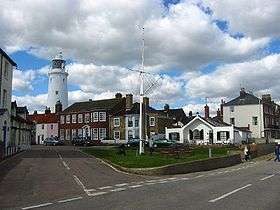 The lighthouse from the North Parade |
|
 Southwold |
|
| Population | 1,098 (2011 Census)[1] |
|---|---|
| OS grid reference | TM510763 |
| District | Waveney |
| Shire county | Suffolk |
| Region | East |
| Country | England |
| Sovereign state | United Kingdom |
| Post town | SOUTHWOLD |
| Postcode district | IP18 |
| Dialling code | 01502 |
| Police | Suffolk |
| Fire | Suffolk |
| Ambulance | East of England |
| EU Parliament | East of England |
| UK Parliament | Suffolk Coastal |
Coordinates: 52°19′37″N 1°40′48″E / 52.327°N 1.680°E
Southwold is a small town on the English North Sea coast in the Waveney district of Suffolk. It lies at the mouth of the River Blyth within the Suffolk Coast and Heaths Area of Outstanding Natural Beauty. The town is about 11 miles (18 km) south of Lowestoft, 29 miles (47 km) north-east of Ipswich and 97 miles (156 km) north-east of London, within the parliamentary constituency of Suffolk Coastal. The "All Usual Residents" 2011 Census figure gives a total of 1,098 persons for the town. The 2012 Housing Report by the Southwold and Reydon Society concluded that 49 per cent of the dwellings in the town are used as second homes and let to holiday-makers. [2]
History
Southwold was mentioned in Domesday Book (1086) as a fishing port, and after the "capricious River Blyth withdrew from Dunwich in 1328, bringing trade to Southwold in the 15th century",[3] it received its town charter from Henry VII in 1489. Over the following centuries, however, a shingle bar built up across the harbour mouth, preventing the town from becoming a major Early Modern port: "The shingle at Southwold Harbour, the mouth of the Blyth, is ever shifting," William Whittaker observed in 1887.[4]
Southwold was the home of a number of Puritan emigrants to the Massachusetts Bay Colony in the 1630s, notably a party of 18 assembled under Rev. Young, which travelled in the Mary Ann in 1637.[5] Richard Ibrook, born in Southwold and a former bailiff of the town, emigrated to Hingham, Massachusetts, along with Rev. Peter Hobart, son of Edmund Hobart of Hingham, Norfolk. Rev. Hobart had been an assistant vicar of St Edmund's Church, Southwold after graduating from Magdalene College, Cambridge.[6] Hobart married in America Rebecca Ibrook, daughter of his fellow Puritan Richard Ibrook. The migrants to Hingham were led by Robert Peck, vicar of St Andrew's Church in Hingham and a native of Beccles.[7]
A fire in 1659 devastated most of the town and damaged St Edmund's Church, whose original structure dated from the 12th century. The fire created a number of open spaces within the town which were never rebuilt. Today this "series of varied and very delightful village greens"[8] and the restriction of expansion because of the surrounding marshes, have preserved the town's genteel appearance.
On the green just above the beach, descriptively named Gun Hill, the six 18-pounder cannon commemorate the Battle of Sole Bay, fought in 1672 between English and French fleets on one side and the Dutch (under Michiel de Ruyter) on the other. The battle was bloody but indecisive and many bodies were washed ashore. Southwold Museum has a collection of mementos of the event. It has occasionally been said that these cannon were captured from the Scots at Culloden and given to the town by the Duke of Cumberland, who had landed at Southwold in October 1745 having been recalled from Europe to deal with the Jacobite threat, but they are much larger than those used by Charles Edward Stuart's army in that campaign. During World War I, it was widely thought that these cannon were one reason why this part of the coast was bombarded by the German Fleet as a "fortified coast". In World War II the cannon were prudently removed, reputedly buried for safety, and returned to their former position after hostilities.
Governance
Southwold is part of the Southwold and Reydon electoral ward, in the Waveney District Council area. The population of this ward, taken at the 2011 census, was 3,680; the resident population of the neighbouring village of Reydon was thus more than double that of the town of Southwold.[9] Although the town lost its independent Municipal Borough status in the Local Government reforms of 1974 and consequent incorporation in Waveney District, it continues to have an elected, non-partisan Town Council and Mayor.
Economy

Although once home to a number of different industries, Southwold's economy nowadays is mainly based on services, and particularly hotels, holiday accommodation, catering, and tourism. With the surrounding areas largely given over to agriculture, the town is an important commercial centre for the area, with a number of independent shops, cafés and restaurants; and a market on Mondays and Thursdays. However, there has been a marked trend in recent years for retailing chains, including food and beverages, clothing and stationery shops, to take over formerly independent retail premises.[10]
Adnams Brewery is located in Southwold, and is the town's largest single employer. Although the fishing fleet and the industry generally is much diminished, Southwold Harbour remains one of the main fishing ports on the Suffolk coastline. In 2012, additional facilities for the fleet were constructed there, as part of the repair and reinstatement of the Harbour's North Wall.
Landmarks and features
Railway
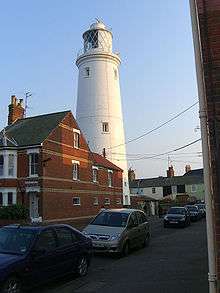
The narrow-gauge Southwold Railway connected the town to Halesworth and ran from 24 September 1879 to 11 April 1929.[11]
In 2007 the Southwold Railway Society submitted plans to build a new line between the parish of Easton Bavents and Henham Park, to link the town to the nearest mainline service at Halesworth.[12] However, these plans were criticised for having no relation to the original route of the railway and for environmental and other reasons. In July 2007 the plans were rejected by both Waveney and Suffolk Coastal District Councils.[13] In December 2008 the Society introduced a new proposal for a Railway Park, including railway track and a museum, on a site at present occupied by a car-breaker's yard, next to the local sewage works.[14] That proposal has been superseded by another, in which a short section of railway, together with other attractions and facilities, would be constructed in the village of Wenhaston, a few miles inland from Southwold and once a stop on the Southwold Railway. The plan has not met with universal approval.[15] In February 2016, the original Railway Park proposal for Blyth Road, Southwold, was revived, and a new planning application submitted.
Lighthouse
Southwold lighthouse was commissioned in 1890 and automated and electrified in 1938.[16] It stands as a prominent landmark in the centre of the town and is a Grade II listed building.[17] It is 31 metres (102 ft) metres tall, standing 37 metres (121 ft) metres above sea level. It is built of brick and painted white and has 113 steps around a spiral staircase.[18]
The lighthouse replaced three local lighthouses that were under serious threat from coastal erosion. It suffered a fire in its original oil fired lamp just six days after commissioning but survived and today operates a rotating 150 watt lamp with a range of 24 nautical miles (44 km; 28 mi).[16][19][20][21] Guided visits are run by the Southwold Millennium Foundation.[18]
Brewery
Adnams Brewery was established in the town by George and Ernest Adnams in 1872 with the purchase of the Sole Bay Brewery which had been established in 1818.[22][23][24] In 1890 the brewery was re-built on its current site in the centre of the town. The brewery is the town's largest employer[23] and has been modernised and expanded in recent years with the development of an energy efficient brewery, a new distribution centre in the nearby village of Reydon, and a distillery.[22][23][24] In 2011 it received the Good Pub Guide Brewery of the Year Award.[25]
Pier
Southwold Pier was built in 1900. At 247 metres (810 ft) it was long enough to accommodate the Belle steamers which carried trippers along the coast at that time. In World War II, it was weakened by two breaches, and in 1955 a large section was destroyed by a gale. The pier was entirely rebuilt and restored in 2001 and is now about 190 metres (620 ft) long. Whilst many English seaside piers are in decline, Southwold Pier is enjoying renewed popularity, helped by a collection of modern coin-operated novelty machines made by Tim Hunkin and the occasional berth of paddle steamers such as PS Waverley and the MV Balmoral.
A model boat pond adjacent to the pier is used for the Southwold Model Yacht regattas that have been held since the late Victorian period.[26] Some of the boats entered are up to 80 years old and include replicas of beach yawls. Regattas are usually held in the spring and summer with the largest, the annual regatta, held at the end of the summer season.
Water towers
The Old Water Tower, in the middle of Southwold Common, was built in 1890. The tank held 40,000 gallons of water and was powered by huge sails. On St Valentine's Day 1899 George Neller, a respected local man, died when his coat got caught in its machinery. In 1937 a new 150,000 gallon capacity Art Deco water tower was built next door. The then Southwold Borough Council bought the Old Water Tower before it came into the hands of successive water companies. It was returned to the Town Council for a nominal fee of £100 in 1987. The Old Water Tower has since been used as the Lifeboat museum and was later used by Adnams for a number of years.[27]
Electric Picture Palace
The Electric Picture Palace cinema was opened in 2002, a pastiche of the original 1912 cinema that stood nearby in York Road.[28]
Southwold Museum
Southwold Museum holds a number of exhibits focused on the local and natural history of the town. The museum is owned and managed by the Southwold Museum & Historical Society. It is part of the Maritime Heritage East programme which unites 43 maritime museums on the East Coast.
St Edmund's Church
The parish church of Southwold is dedicated to St Edmund, and is considered to be one of Suffolk's finest.[29] It lies under one continuous roof, and was built over about 60 years from the 1430s to the 1490s; replacing a smaller 13th-century church that was destroyed by fire. The earlier church dated from the time when Southwold was a small fishing hamlet adjacent to the larger Reydon. By the 15th century Southwold was an important town in its own right, and the church was rebuilt to match its power and wealth.
Southwold Harbour
Southwold Harbour lies south of the town on the River Blyth. Vehicular access is via York Road and Carnsey Road to the west, and Ferry Road to the east. The harbour extends nearly a mile upstream from the river mouth, and is mainly used by fishing boats, yachts and small pleasure boats. The clubhouse of Southwold Sailing Club is on the north side of the harbour.[30] The quay and area in front of the Harbour Inn is called "Blackshore", although this name is often, but incorrectly, used to refer to the whole harbour.
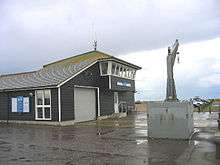
At the seaward end of the harbour is Southwold Lifeboat Station, operated by the RNLI. The former Cromer lifeboat shed houses the Alfred Corry Museum. This features the former Southwold lifeboat "Alfred Corry", which was in service from 1893 to 1918. In a project carried out by volunteers over several years, the boat has undergone an extensive, and now-complete, restoration to her original state.
The river can be crossed on foot or bicycle by a public footbridge upstream from The Harbour Inn, which gives access to the village of Walberswick. This bridge, known as the Bailey Bridge, is based on the footings of the original iron Southwold Railway swing bridge. It replaced that bridge, which contained a central swinging section to allow the passage of wherries and other shipping, and which was largely demolished at the start of World War II as a part of precautions against German invasion.
Towards the mouth of the River Blyth, a rowing boat ferry service runs between the Walberswick and Southwold banks. The ferry has been operated by the same family since the 1920s, when it was a chain ferry that could take cars. The chain ferry ceased working in 1941, but some small vestiges remain at the Walberswick slipway.
Southwold beach
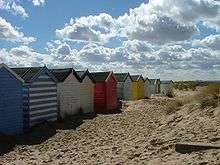
The beach is a combination of sand and shingle. In 2005/6 it was further protected by a coastal management scheme which includes beach nourishment, new groynes on the south side of the pier and riprap to the north.
It is overlooked by brightly painted beach huts.
Culture
Television
The fictional Southwold Estate, seat of the equally fictional Earls of Southwold, is the country estate of the family of Lady Marjorie Bellamy in the ITV British drama Upstairs, Downstairs. The town and its vicinity has been used as the setting for numerous films and television programmes, including Iris about the life of Iris Murdoch starring Judi Dench; Drowning by Numbers by Peter Greenaway; Kavanagh QC starring John Thaw; 'East of Ipswich' by Michael Palin; Little Britain with Matt Lucas and David Walliams; and a 1969 version of David Copperfield.[31] The BBC children's series Grandpa in My Pocket is filmed in Southwold, Walberswick and Aldeburgh.[32] Only exteriors of buildings were filmed – no acting was done there. ITV drama, A Mother's Son, was recently filmed on location in Southwold. It was broadcast on ITV1 in September 2012.
Novels
Julie Myerson, setting her 2003 murder novel Something Might Happen in an unnamed Southwold, calls it "a sleepy, slightly self-satisfied seaside town". The town isn't named, but Myerson stated that setting a murder in the car park did make her feel as if she "was soiling something really good". She holidayed in the town as a child and remarked in an interview that while everything else in her life had changed, her mother and Southwold had remained the same. She still owns a second home in the town.[33] Other books set in Southwold include Esther Freud's novel Sea House (2004), with Southwold as Steerborough[34] Southwold native Neil Bell in Bredon and Sons (1933, about boat-building people) and Forgive us our Trespasses (1947, based on a true story of twin boys lost at sea) renames the town Senwich.[35] The Bookshop by Penelope Fitzgerald (1978) drew on her experiences working in a Southwold bookshop in the 1950s.[36] An earlier book thought to be set in Southwold is Beside the Guns (1902) by the Christian author Mary Elizabeth Shipley. The writer W.G. Sebald describes Southwold in The Rings of Saturn (Die Ringe des Saturn, 1995, tr. Michael Hulse), an account of a walk through East Anglia.
George Orwell
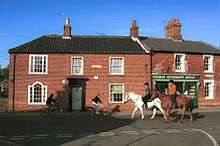
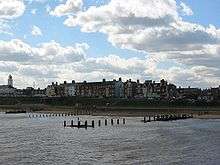
The writer George Orwell (then known as Eric Blair) spent time as a teenager and in his thirties in Southwold, living at his parents' home. A plaque can be seen next door to what is now the fish and chip shop at the far end of the High Street.
From January to June 1922 he attended a cramming establishment in Southwold to prepare for his Indian Police Service exams and his career in Burma. In 1929 after eighteen months in Paris he returned to the family home at Southwold and spent most of the next five years based at Southwold. He tutored a disabled child and a family of three boys during this time and wrote reviews and developed Burmese Days. During this period he spent nearly eighteen months teaching in West London until he had a serious bout of pneumonia. His mother then insisted that he stay at home instead of carrying on teaching and he spent the time writing A Clergyman's Daughter. The novel is partly set in a fictionalised East Anglian town called "Knype Hill". His final visit to Southwold was in 1939.
Cultural events
The town has a history of hosting summer repertory theatre, staged by different companies. For several years, Suffolk Summer Theatres have offered a varied programme of plays from July to September, which are staged in St. Edmund's Hall.
Annually, in November, the "Ways with Words" literature festival is held in the town, with many notable speakers appearing at different venues.
2014 saw the staging of the inaugural Southwold Arts Festival, which is planned to be repeated in future years. The festival offers a mix of literature, music, film and art exhibitions, with the main events occurring over an 8-day period in the summer. The 2016 festival featured entertainers such as Charles Dickens and Publisher Martin Adeney. The festival continues its legacy of bringing entertainers of diverse backgrounds together.[37]
In 2005, Southwold launched Suffolk's "answer to the Turner prize", the "Flying Egg" competition. This event also ran in 2006 and 2007, but was not repeated in 2008.[38]
See also
- Latitude festival
- Southold (CDP), New York – village on Long Island, NY
- Southold, New York – named after Southwold, UK
- Southwold, Ontario – Canadian link
- Rev. John Youngs – founder of Southold, NY
References
- ↑ "Town population 2011". Retrieved 20 September 2015.
- ↑ "Southwold and Reydon Society Housing Report 2012" (PDF). Retrieved 29 September 2016.
- ↑ Norman Scarfe, Suffolk in the Middle Ages: Studies in Places and Place-Names, 2004:161
- ↑ W. Whitaker, The Geology of Southwold, and of the Suffolk coast from Dunwich to Covehithe: (Explanation of sheet 49 N.) 1887: "Coast deposits" pp 45ff; the coastal spits and bars are discussed in J. Steers, "The East Anglian Coast", The Geographical Journal 69.1, January 1927.
- ↑ Roger Thompson, Mobility and Migration: East Anglian Founders of New England, 1629–1640 2009:188, et passim.
- ↑ Mr. Richard Ibrooke, Suffolk Deeds, William Blake Trask, Frank Eliot Bradish, Charles A. Drew, A. Grace, Rockwell and Churchill Press, Boston, 1908. Books.google.com. Retrieved 23 February 2013.
- ↑ "Peck, Robert (PK598R2)". A Cambridge Alumni Database. University of Cambridge.
- ↑ Scarfe 2004:125.
- ↑ "Southwold and Reydon ward population 2011". Retrieved 20 September 2015.
- ↑ "Organisation warns Southwold's unique character could be lost". Lowestoft Journal. 27 April 2012.
- ↑ Mitchell, V.; Smith, K. (1984). Branch Line to Southwold. Middleton Press. ISBN 0-906520-15-0.
- ↑ "The Project to Re-instate the Southwold Railway". Southwoldrailway.co.uk. 5 July 2007. Retrieved 23 February 2013.
- ↑ "Southwold railway – last hopes dashed". EADT online. 5 July 2007. Retrieved 20 July 2006.
- ↑ "Tentative Approval for Southwold Railway". Norwich Advertiser. 18 December 2008.
- ↑ "Wenhaston villagers hope to derail Southwold Railway Trust plans". Lowestoft Journal. 25 May 2012.
- 1 2 Southwold, Trinity House. Retrieved 29 October 2012.
- ↑ The Lighthouse, Southwold, British Listed Building. Retrieved 29 October 2012.
- 1 2 See inside a lighthouse, Trinity House. Retrieved 29 October 2012.
- ↑ Application note 32064 – Southwold Conversion, Pelangi. Retrieved 4 January 2013.
- ↑ Discovering Southwold, BBC Suffolk. Retrieved 29 October 2012.
- ↑ The sea – Southwold's lighthouse, Southwold museum. Retrieved 29 October 2012.
- 1 2 Suffolk brewer Adnams starts distillery, BBC news website, 12 November 2010. Retrieved 2013-01-02.
- 1 2 3 Point 7 – The Brewery, BBC Suffolk. Retrieved 2 January 2013.
- 1 2 Our history, Adnams. Retrieved 2 January 2013.
- ↑ Adnams claims national title, Eastern Daily Press, 7 October 2010. Retrieved 2013-01-02.
- ↑ The SMYR Handbook, Southwold Model Yacht Regattas. Retrieved 30 October 2012.
- ↑ "The So Southwold Office at the Old Water Tower". www.sosouthwold.co.uk. Retrieved 2016-09-28.
- ↑ "About Us - The Electric Picture Palace, Southwold". Retrieved 2016-09-28.
- ↑ "Simon Jenkin's top Suffolk churches". Suffolkchurches.co.uk. Retrieved 2013-02-23.
- ↑ Harbour Marine Services Guide Archived 12 December 2010 at the Wayback Machine.
- ↑ "David Copperfield". Old City. 8 November 2004. Retrieved 23 February 2013.
- ↑ BBC press release Retrieved 26 April 2012
- ↑ Random House Archived 14 May 2008 at the Wayback Machine.
- ↑ Kellaway, Kate (2003-07-05). "Mysteries under an open Suffolk sky - once you've got your bearings". The Guardian. ISSN 0261-3077. Retrieved 2016-09-28.
- ↑ "Southwold Culture". www.triposo.com. Retrieved 2016-09-28.
- ↑ The Independent 24 August 2008, review of her published correspondence: Retrieved 31 May 2012.
- ↑ "2016 Festival – Southwold Arts Festival". southwoldartsfestival.co.uk. Retrieved 2016-09-28.
- ↑ "Telegraph news 01/08/2005". Telegraph.co.uk. Retrieved 23 February 2013.
External sources
- Munn, Geoffrey, Southwold: An Earthly Paradise, Antique Collectors Club, (Woodbridge, 2006) ISBN 1851495185
External links
| Wikimedia Commons has media related to Southwold. |
| Wikivoyage has a travel guide for Southwold. |
- A Short History of the Southwold Railway
- Southwold Museum
- A history of Southwold's shops and trades
- Online edition of free monthly newspaper Southwold Organ
- The "Alfred Corry" Museum
- Southwold Guided Tour
- Southwold Online
- Explore Southwold